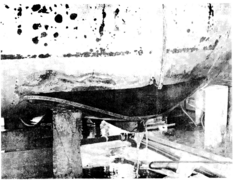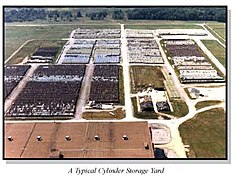Uranium hexafluoride
You can help expand this article with text translated from the corresponding article in German. (November 2012) Click [show] for important translation instructions.
|

| |
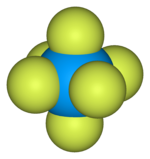
| |
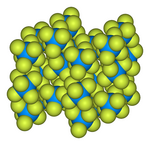
| |
| Names | |
|---|---|
| IUPAC names
Uranium hexafluoride
Uranium(VI) fluoride | |
| Identifiers | |
3D model (
JSmol ) |
|
| Abbreviations | hex |
| ChEBI | |
| ChemSpider | |
ECHA InfoCard
|
100.029.116 |
| EC Number |
|
| 2923 | |
PubChem CID
|
|
RTECS number
|
|
| UNII | |
| UN number | 2978 (<1% 235U) 2977 (>1% 235U) |
CompTox Dashboard (EPA)
|
|
| |
| |
| Properties | |
| UF6 | |
| Molar mass | 352.02 g/mol |
| Appearance | Colorless solid |
| Density | 5.09 g/cm3, solid |
| Boiling point | 56.5 °C (133.7 °F; 329.6 K) (sublimes, at atmospheric pressure) |
| Hydrolyzes | |
| Solubility |
|
| Structure | |
Orthorhombic, oP28
| |
| Pnma, No. 62 | |
| Octahedral (Oh) | |
| 0 | |
| Thermochemistry | |
Std molar
entropy (S⦵298) |
|
Std enthalpy of (ΔfH⦵298)formation |
|
| Hazards | |
| Occupational safety and health (OHS/OSH): | |
Main hazards
|
Toxic, corrosive, radioactive[3] |
| GHS labelling: | |
  
| |
| Danger | |
| H300, H330, H373, H411 | |
| NFPA 704 (fire diamond) | |
| Flash point | Non-flammable |
| Safety data sheet (SDS) | ICSC 1250 |
| Related compounds | |
Other anions
|
Uranium hexachloride |
Other cations
|
|
Related uranium fluorides
|
|
Except where otherwise noted, data are given for materials in their standard state (at 25 °C [77 °F], 100 kPa).
| |
Uranium hexafluoride, sometimes called hex, is an inorganic compound with the formula UF6. Uranium hexafluoride is a volatile and toxic white solid that reacts with water, releasing corrosive hydrofluoric acid. The compound reacts mildly with aluminium, forming a thin surface layer of AlF3 that resists any further reaction from the compound. UF6 is used in the process of enriching uranium, which produces fuel for nuclear reactors and nuclear weapons.
Preparation
Milled uranium ore—U3O8 or "
The Honeywell Uranium Hexafluoride Processing Facility uses a different process.
During nuclear reprocessing, uranium is reacted with chlorine trifluoride to give UF6:
- U + 2 ClF3 → UF6 + Cl2
Properties
Physical properties
At atmospheric pressure, UF6 sublimes at 56.5 °C.[4]

The solid-state structure was determined by neutron diffraction at 77 K and 293 K.[5][6]
-
Ball-and-stick model of the unit cell of uranium hexafluoride[7]
-
Bond lengths and angles of gaseous uranium hexafluoride[8]
Chemical properties
It has been shown that uranium hexafluoride is an
Polymeric uranium(VI) fluorides containing organic cations have been isolated and characterized by X-ray diffraction.[11]
Application in the fuel cycle
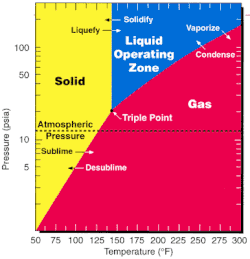
As one of the most
Fluorine has only a single naturally occurring stable isotope, so isotopologues of UF6 differ in their molecular weight based solely on the uranium isotope present.[13] This difference is the basis for the physical separation of isotopes in enrichment.
All the other uranium fluorides are nonvolatile solids that are coordination polymers.
The conversion factor for the 238U isotopologue of UF6 ("hex") to "U mass" is 0.676.[14]
Gaseous diffusion requires about 60 times as much energy as the gas centrifuge process: gaseous diffusion-produced nuclear fuel produces 25 times more energy than is used in the diffusion process, while centrifuge-produced fuel produces 1,500 times more energy than is used in the centrifuge process.
In addition to its use in enrichment, uranium hexafluoride has been used in an advanced reprocessing method (
Uranium enrichment produces large quantities of depleted uranium hexafluoride (DUF6 or D-UF6) as a waste product. The long-term storage of D-UF6 presents environmental, health, and safety risks because of its chemical instability. When UF6 is exposed to moist air, it reacts with the water in the air to produce UO2F2 (uranyl fluoride) and HF (hydrogen fluoride) both of which are highly corrosive and toxic. In 2005, 686,500 tonnes of D-UF6 was housed in 57,122 storage cylinders located near Portsmouth, Ohio; Oak Ridge, Tennessee; and Paducah, Kentucky.[15][16] Storage cylinders must be regularly inspected for signs of corrosion and leaks. The estimated lifetime of the steel cylinders is measured in decades.[17]
Accidents and Disposal
There have been several accidents involving uranium hexafluoride in the US, including a cylinder-filling accident and material release at the
References
- ^ "Uranium Hexafluoride". Archived from the original on 2013-09-16. Retrieved 2013-08-08.
- ^ .
- ^ Uranium(VI) fluoride
- .
- .
- .
- .
- doi:10.1063/1.1669727. Archived from the originalon 2023-01-11. Retrieved 2020-10-10.
- .
- .
- .
- ^ "Uranium Hexafluoride: Source: Appendix A of the PEIS (DOE/EIS-0269): Physical Properties". web.evs.anl.gov. Retrieved 2022-08-18.
- ^ "Uranium Enrichment and the Gaseous Diffusion Process". USEC Inc. Archived from the original on 2007-10-19. Retrieved 2007-09-24.
- ^ "Unit converter molar mass calculator". TranslatorsCafé. Mississauga, Ontario, Canada: ANVICA Software Development. 1 February 2021.
- ^ "How much depleted uranium hexafluoride is stored in the United States?". Depleted UF6 FAQs. Argonne National Laboratory.
- ^ "Depleted UF6 Management Program Documents". Archived from the original on 2008-02-16. Retrieved 2006-05-17.
- ^ "What is DUF6? Is it dangerous and what should we do with it?". Institute for Energy and Environmental Research. 2007-09-24.
- ^ "The Sequoyah Corporation Fuels Release and the Church Rock Spill: Unpublicized Nuclear Releases in American Indian Communities" Authors Doug Brugge, Jamie L. deLemos, and Cat Bui. September 2007. PMCID:PMC1963288 PMID: 17666688
- ^ "Have there been accidents involving uranium hexafluoride?". Depleted UF6 FAQs. Argonne National Laboratory. Archived from the original on 2017-06-09.
- ^ "What is going to happen to the uranium hexafluoride stored in the United States?". Depleted UF6 FAQs. Argonne National Laboratory.
- ^ "Are there any currently-operating disposal facilities that can accept all of the depleted uranium oxide that would be generated from conversion of DOE's depleted UF6 inventory?". Depleted UF6 FAQs. Argonne National Laboratory.
Further reading
- Gmelins Handbuch der anorganischen Chemie, System Nr. 55, Uran, Teil A, p. 121–123.
- Gmelins Handbuch der anorganischen Chemie, System Nr. 55, Uran, Teil C 8, p. 71–163.
- R. DeWitt: Uranium hexafluoride: A survey of the physico-chemical properties, Technical report, GAT-280; Goodyear Atomic Corp., Portsmouth, Ohio; 12. August 1960; doi:10.2172/4025868.
- Ingmar Grenthe, Janusz Drożdżynński, Takeo Fujino, Edgar C. Buck, (p. 530–531, 557–564).
- US-Patent 2535572: Preparation of UF6; 26. December 1950.
- US-Patent 5723837: Uranium Hexafluoride Purification; 3. March 1998.
External links
- Simon Cotton (Uppingham School, Rutland, UK): Uranium Hexafluoride.
- Uranium Hexafluoride (UF6) – Physical and chemical properties of UF6, and its use in uranium processing – Uranium Hexafluoride and Its Properties
- Uranium Hexafluoride at WebElements
- Import of Western depleted uranium hexafluoride (uranium tails) to Russia [dead link 30 June 2017]


![Ball-and-stick model of the unit cell of uranium hexafluoride[7]](http://upload.wikimedia.org/wikipedia/commons/thumb/c/c6/Uranium-hexafluoride-unit-cell-3D-balls.png/180px-Uranium-hexafluoride-unit-cell-3D-balls.png)
![Bond lengths and angles of gaseous uranium hexafluoride[8]](http://upload.wikimedia.org/wikipedia/commons/thumb/4/4c/Uranium_hexafluoride_dimensions.svg/180px-Uranium_hexafluoride_dimensions.svg.png)
